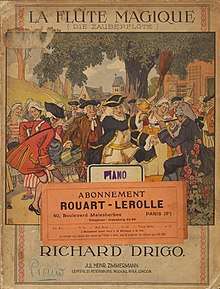The Magic Flute (ballet)
La flûte magique (en. The Magic Flute) (ru. «Волшебная флейта», Volshebnaya Fleita) is a ballet comique in one act, originally choreographed by Lev Ivanov to the music of Riccardo Drigo. Although it has the same title as Mozart's opera The Magic Flute, the two works have no other connection.[1] First presented by students of the Imperial Ballet School at the school's theatre on 4 February [O.S. 23 January] 1893. The principal ballerina role of Lise was created by Stanislava Belinskaya, while the principal male role of Luc was created by Mikhail Fokine.

La flûte magique was transferred to the repertory of the Imperial Ballet, where it was first presented on 23 April [O.S. 11 April] 1893 at the Imperial Mariinsky Theatre with Anna Johansson in the role of Lise and Pavel Gerdt in the role of Luc. The ballet served as a useful vehicle for the ballerinas of the Tsarist stage including Anna Pavlova, who would later include the work in the repertory of her own touring company.[1]
Drigo's score was later published in piano reduction and orchestral partition by the music publisher Zimmerman in 1912. The score was recorded in 1990 by the Orchestra of the Royal Opera House, Covent Garden, conducted by Richard Bonynge and issued on the label London.
The ballet has been re-staged in several versions, notably by Peter Martins for the School of American Ballet. This production was first presented on 9 May 1981. A second premiere was given by the New York City Ballet on 21 January 1982, at the New York State Theater, Lincoln Center with décor designed by David Mitchell, costumes by Ben Benson.
Structure
List of scenes and dances from The Magic Flute taken from the published piano score and the original program of 1893. All libretti and programs of works performed on the stages of the Imperial Russian Theatres were titled in French, which was the official language of the Imperial Court as well as the language from which balletic terminology is derived.
Ballet comique in one act
- no.01 Prélude et scène
- no.02 Danse villageoise
- no.03 Scène: La fermière
- no.04 Arrivée du coureur
- no.05 Arrivée du Marquis
- no.06 Pas d'action
- no.07 Le menuet du Marquis
- no.08 Variation de Lise (Mlle. Stanislava Belinskaya)
- no.09 La Farandole
- no.10 Scène: Désespoir de Luc
- no.11 Scène: Arrivée de l'ermite
- no.12 "Une Flûte enchantée": Danse forcée (ancien air de ballet d'auter inconnu)
- no.13 Scène d'amour I: Lise et Luc
- no.14 Scène d'amour II: andante
- no.15 Scène: Fureur de la fermière et danses forcées
- no.16 Scène: L'apparition d'Obéron
- no.17 Grand Pas d'ensemble —
- a. Grand adage (cadence de violon pour M. Léopold Auer)
- b. Variation pour quatre danseuses
- c. Variation de Luc (M. Mikhail Fokine)
- d. Pizzicato de Lise (Mlle. Stanislava Belinskaya)
- e. Grand ballabile